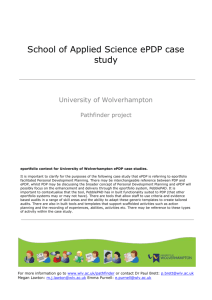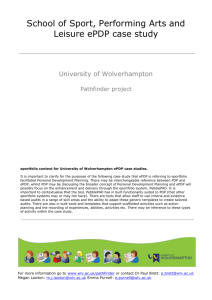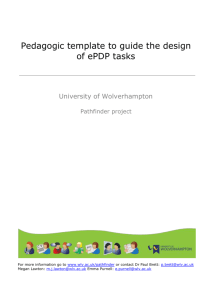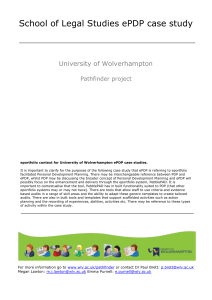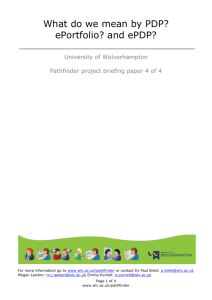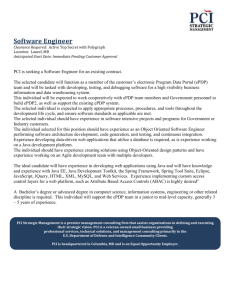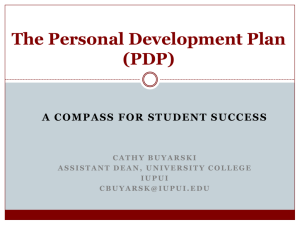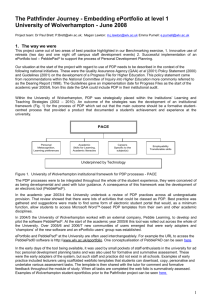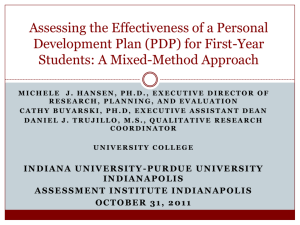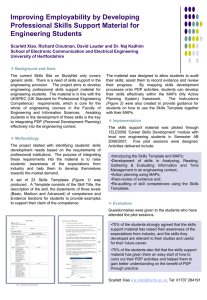Student evaluation and learner voice
advertisement
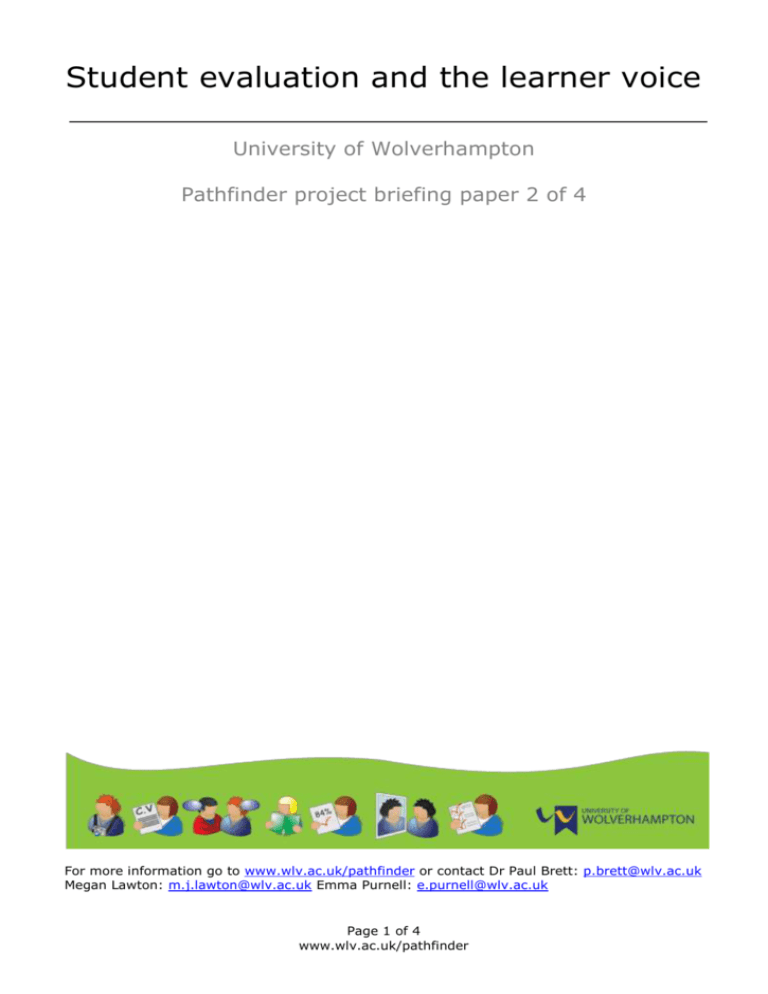
Student evaluation and the learner voice University of Wolverhampton Pathfinder project briefing paper 2 of 4 For more information go to www.wlv.ac.uk/pathfinder or contact Dr Paul Brett: p.brett@wlv.ac.uk Megan Lawton: m.j.lawton@wlv.ac.uk Emma Purnell: e.purnell@wlv.ac.uk Page 1 of 4 www.wlv.ac.uk/pathfinder Student evaluation and learner voice briefing paper Context The project aimed to enhance capacity for, and improved quality of, our students’ learning across the Level 1 curriculum, through the design and implementation of module-based ePortfolio mediated PDP tasks. These tasks will facilitate reflection on a variety of learning related issues to enable learners to better meet the challenges of HE. These activities are seen as being especially useful to the diverse student body at University of Wolverhampton, which has the highest percentage of students historically under-represented in HE in the UK. The University has over 22,000 students of which 66% are mature. Over quarter of the mature students and about half of the 18 year olds are first generation learners; over 50% enter the University from regional partner colleges and local schools; and over 10,000 students study part-time. Some of these learners have lacked confidence in their study skills, have not recently been in study situations, have unrealistic expectations of the nature of study in Higher Education, and are unaware of the need to plan, manage and assume responsibility for their learning. Systematic engagement of our learners in some of the reflective processes enabled by e-Portfolio activities aims to address issues such as these, and improve student learning as found by Peters (2006) 1. The project focuses on Level 1 learners so as to provide those at the start of their University career with a range of appropriate opportunities to think about their learning, to develop their own learner identity and provide strategies for reflection on learning which will remain in their following years of study. In the longer term, through an electronic collection of evidence of their learner journey and attainment, students may be able to demonstrate more easily their employability.The project included 31 members of staff, consisting of both Mentors and Tutors. There was a focus on 21 modules with 1810 students, across a range of disciplines such as Writing, Dance, Drama, Education, Engineering and the Built Environment, Health, Human Resource Management, Interpreting (British Sign Language/English), Legal Studies, Mathematics, Pharmacy, Psychology, Social Work, Visual Communication. Through developing an evaluation strategy during the early stages of the project we identified 5 key questions that were important to answer as part of our Pathfinder project. The criteria approach taken when identifying questions for our project evaluation we looked to have a meta level question, which can be seen in question 1, where we wanted to look at the facilitating and inhibiting factors that would be at the hear to f the project. Questions 2, 4 and 5 were aimed at focusing in on the activities and stakeholders involved in the project. It was important to include a question that focused on the institutional audience and the potential of sustainability. With this in mind question 3 looks at the effectiveness of the project from a university perspective. As question 3 had the institutional focus it was also the key focal point for the parallel external evaluation. The following report gives an overview of the data collected throughout the project and how it answered the questions outlined. Obviously the focus of this briefing paper is covered in question 4. 1. What are the facilitating and inhibiting factors of implementing and embedding ePDP into level 1 modules? 2. What scaffolded activities do staff put in place to support pdp via and eportfolio system, why, and how are the outcomes evidenced? 3. How far does the mentoring model developed through retreats and a focused immersion model, represent a (cost) effective strategy for staff development for the university? 4. What are student perceptions of ePDP? What are the characteristics of a student ePDP experiences? 5. What impact has there been on the academic practice of those staff involved in the project?2 Peters, J. (2006) Researching student attitudes to Personal Development Planning (PDP). Available online at http://www.heacademy.ac.uk/learningandteaching/newsletterPDPUKmar06.pdf. Accessed Feb, 9th 2007. 2 This question has changed from the original question in our project plan. The original question was ‘Does ePDP engagement affect learner success rates?’ With the agreement of the Higher Education Academy, it was decided that in the time frame of the project that this question could not be answered as learner grades would not have been finalised in time to analyse learner success rates in relation to ePDP. We felt that it was more appropriate to align this question with the impact on staff academic practice as the key theme of our project is staff development. 1 Page 2 of 4 www.wlv.ac.uk/pathfinder The scope of the data collected for the evaluation was as follows: o 606 student questionnaires. o 81 staff questionnaires (consisting of interim, end of project and retreat specific questionnaires) o 3 hours of video of staff feedback presentations. o 2 hours audio of staff final interviews. o External evaluation of telephone interviews with Associate Deans within the project schools (separate link to this report can be found here) Scaffolded activites put in place to support Personal Development Planning in the identified curriculum Staff experience and expertise in PDP and eportfolio technology varied from little or no experience in either or both of these areas, through to early adopter champions in both eportfolio and PDP. Therefore, there was a range of PDP activities that staff chose to integrate into their curriculum. The range of activities were catagorised using Ward and Richardson (2007) PDP activities and can be seen here Activities included structured and scaffolded action plans, bespoke skills audits, entire eportfolio templates with a series of activities and ‘gapped handout’ style pages, a number of reflection on and for learning and self type activities and many more. Important to the project and future sustainability are the reasons why staff chose particular activities and how they planned the outcomes of these activities to enhance skills development and learning in a number of areas. Staff outlined a number of reasons as to the motivations behind their choice of ePDP tasks. For many staff it was to enhance and develop reflection skills, both reflection on self and on learning. Eportfolio would allow extra thinking time and space and provide a platform for anytime-anyplace learning. The development of study skills and skills needed to be an HE student was a recurrent motivation for staff in the activities they choose. Staff was keen to transfer existing paper PDP tasks online as they felt it would allow for an easier, more timely and more reciprocal feedback process. By transferring tasks online it made the potential to stitch together these ‘chunks’ of learning a new and exciting prospect. The opportunity for creativity was key in some staff choices, where ePDP activities were chosen and developed that required some form of multimedia engagement or representation of learning using multimedia. As part of the project evaluation we asked which areas of skill development and learning the staff were aiming to enhance with the chosen ePDP activities. These are shown below: o Study skills o Reflection o Self analysis o Confidence o Self esteem o Sense of belonging o Subject knowledge o Collaboration o Critical thinking o Meta cognition, learning how to learn Student perceptions and learner voice The evaluation of this project has shown that students like using electronic methods for their learning and teaching but that they must see a value and benefit by undertaking those activities. They found the ability to go backwards and look at their previous work, as well as plan forwards was really useful. We have found that the majority of students have enjoyed participating in eportfolio and ePDP (75% of those who responded to the evaluation questionnaires) and those who haven’t have given us some valuable ideas on plans to develop wider engagement. It is key that feedback expectations are set and met and that ePDP tasks are chosen carefully to ensure meaningful feedback can be given and not lost within too many different activities. Less can often be more with ePDP activities, less activities, more focused feedback. Tutor enthusiasm is infectious; tutor needs to be convinced of the value of ePDP if they want to enthuse their students. It was interesting to see that in some of the student negative feedback Page 3 of 4 www.wlv.ac.uk/pathfinder that they commented that they didn’t like using the eportfolio, however, when you delve into some of the reasons it was interesting to see that it was not always the technology itself but at times highlighted multiple wider curriculum issues with assessment or suitability of the task with the technology, however, interestingly, although 75% of students said they enjoyed the ePDP tasks in PebblePAD, 35% commented that they would have rather done the PDP task on part. On a practical level, 62% of students commented that making a connection to the technology in the classroom helped them to buy into activities and additional workshop support outside of the classroom was highlighted as one of the most important provisions of support given with 80% saying that the help and support given was adequate in enabling them to complete the tasks in PebblePAD. As mentioned earlier, staff would have liked to have had more time to conceptualise PDP, this was a similar situation with many of the students, as 80% of respondent students found it difficult to articulate what PDP was, even though 90% confirmed that it had been explained to them in class. In relation to the level of complexity of ePDP tasks 60% of students said that the tasks were pitched at the right level for their learning at level 1. ‘Really enjoyable. Can write my feelings etc down better than verbalising them!’ ‘Using PebblePAD helps to break tasks down for you into manageable chunks’ ‘Using PebblePAD for PDP has helped me understand what I have learned in this module and in relation to other modules’ ‘The tasks were really helpful in helping me identify my strengths and weaknesses and where I need to focus on to improve these’ ‘I really enjoyed the ePDP tasks and intend to use the eportfolio to help me structure my learning in the rest of my degree’ ‘Really enjoyable. Can write my feelings etc down better than verbalising them!’ ‘Using PebblePAD helps to break tasks down for you into manageable chunks’ ‘Using PebblePAD for PDP has helped me understand what I have learned in this module and in relation to other modules’ ‘The tasks were really helpful in helping me identify my strengths and weaknesses and where I need to focus on to improve these’ ‘I really enjoyed the ePDP tasks and intend to use the eportfolio to help me structure my learning in the rest of my degree’ For more information go to www.wlv.ac.uk/pathfinder or contact Dr Paul Brett: p.brett@wlv.ac.uk Megan Lawton: m.j.lawton@wlv.ac.uk Emma Purnell: e.purnell@wlv.ac.uk Page 4 of 4 www.wlv.ac.uk/pathfinder
